By Sujith Kumar Prankumar, Katherine O’Chee and Supharirk James Chiraphatnachai
Art is ubiquitous across human culture. Described as both “a record of the past” and a “catalyst for cultural change”,1 artistic expression helps us understand and articulate experiences and meanings of life and the world,2 transmit religious, cultural and ethical values,3 and promote healing.4 While it can be difficult to describe the world using words, “art can teach us to reproduce it”.5 Artistic creations, in their explorations of social issues and everyday life, confront the conscience of society in various ways. These works can reflect collective memory and suggest new possibilities, or highlight common human experiences through a confessional approach. By opening new windows and uncovering hidden worlds, art can build empathy, bring the unknown into familiar ground, and rekindle forgotten desires.6
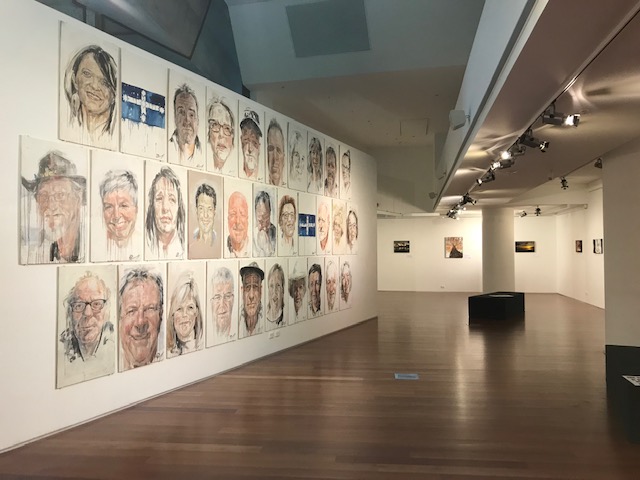
Portraits by Daniel Butterworth. Photo courtesy of Vanessa Beetham, The Dax Centre.
Literature
Literature is often used for social and political commentary,7 and can be an effective platform for discussing issues about social justice and the human experience. Two examples are prison literature and poetry.
Prison Literature
Prison literature features writing by detained, incarcerated or otherwise involuntarily confined individuals, and is concerned with themes of resistance, civil disobedience and social consciousness. The social impact of prison literature is not limited to its consumers; it also extends to prisoners and others involved in facilitating and participating in prison reading and writing projects, as these provide avenues for “radical pedagogy and social transformation”.8 A recent work is Kurdish Iranian refugee Behrouz Boochani’s No Friend But The Mountains.9 In this sobering memoir, the author provides a glimpse into the harsh realities of prisoners’ lives on Manus Island in Papua New Guinea, where refugees and asylum-seekers coming into Australia by boat have been routed.
“One must have recourse to art and literature if one is to keep alive a sense of what hard science … often forgoes or forgets.” —Existential anthropologist Michael Jackson10
Poetry
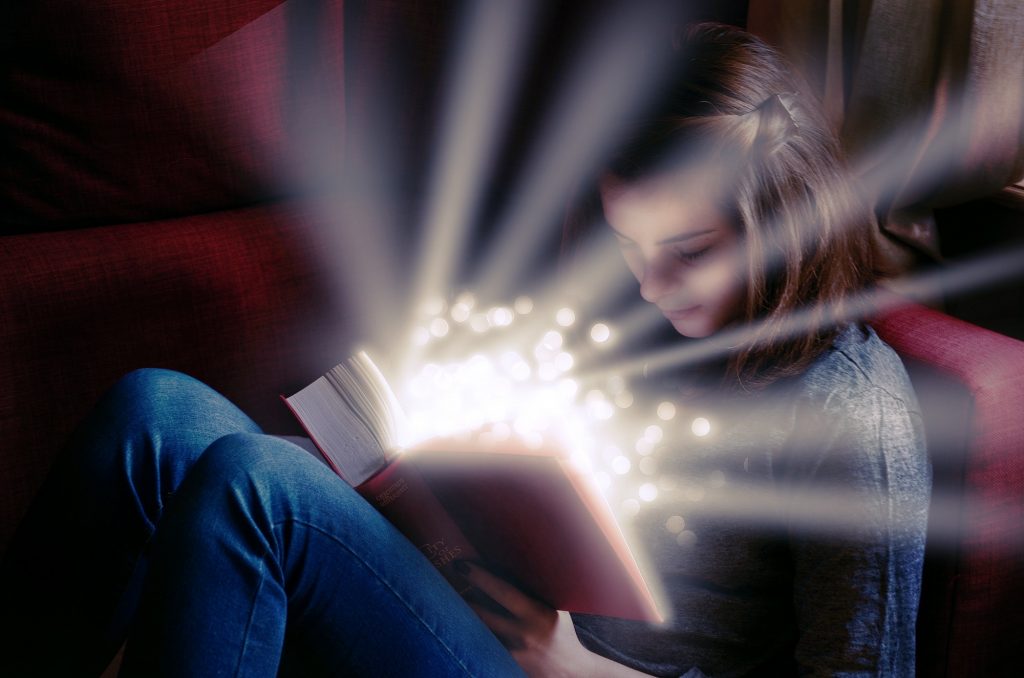
Source: Pexels.
Poetry can be an intimate, evocative and succinct form of social critique. Many poems touch on themes such as “institutional legitimacy, disciplinary practice, and citizenship”,11 and have “commemorated and satirised the most momentous and trivial of political controversies”.12 For example, in a devastating response to police brutality against African-American men, poet and MacArthur ‘Genius’ Grant recipient Claudia Rankine wrote: “because white men can’t / police their imagination / black men are dying.”13 Poetry is also a powerful means to strengthen cultural identity and belonging, and deaf slam poetry is one such example.
“All art is a kind of confession … if you can examine and face your life, you can discover the terms with which you are connected to other lives, and they can discover, too, the terms with which they are connected to other people.” —Novelist and social critic James Baldwin14
Deaf Slam Poetry It seems counter-intuitive that deaf people would be drawn to poetry, as poetry has traditionally emphasised sound. Deaf slam poetry aims to make poetic content more accessible to deaf and hearing-impaired persons, as well as strengthen the cultural development of the deaf community.15 A relatively new phenomenon—although the Chicago-originated slam poetry has been popular for many years—deaf slam poetry defies the misconception of poetry as an exclusively aural form only to be enjoyed by hearing people. This art form is increasingly being introduced to worldwide audiences thanks to passionate deaf slam poets such as Douglas Ridloff, who took the art form to France and Cuba,16 and Honesty Willoughby, who competed in a deaf poetry slam in the UK.17 Australia has also contributed to building interest in deaf slam poetry through several deaf slam poetry workshops that have been organised there.18
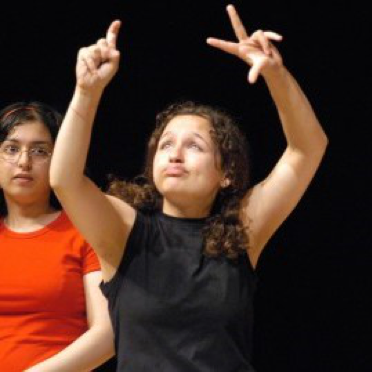
Aneta Brodski signing her poetry.19 Source: PBS.
Through sign language, poetry can become a truly embodied experience, collapsing the distance between poet and text. Whereas hearing people can simply grab a book of poetry (by hearing poets) from the shelf, deaf people see deaf poetry as intertwined with (and perhaps inseparable from) the poet. Deaf poetry can be more dynamic, deriving its ambiguity from its gestures, which can bleed from word to word as in a rhyme. One handshape, Ridloff demonstrates, “can represent a multitude of concepts”—as in how the handshape for “rooster” also means “car”.20 Head tilts, nods, or shakes, as well as raised eyebrows and lip movements, can greatly modify word meanings.
“I am the book”—deaf poet Paul Scott.21
Topics in slam poetry vary, but generally emphasise self-authentication.22 Slam poetry grants deaf poets a valuable platform for self-expression and affirmation. For example, Willoughby practised extensively for her routine in the UK’s first sign-language poetry slam. Coming in third, she nevertheless celebrated her experience: “I’m a little disappointed I didn’t win, but it’s still an achievement to have done it. I’m feeling content.”23 But while deaf slam poetry usually centres on the self (of the performer), it can also be a collaborative activity—and not only between poet and audience. Take, for instance, Aneta Brodski, a deaf Israeli poet who teamed up with hearing Palestinian spoken-word poet Tahani Salah, to perform a slam-poetry duet about overcoming their differences and striving for peace. During their segment, Tahani read out their poem while Aneta, standing beside her, signed its contents. “Two languages. Two cultures. One poem,” their host announced after their performance at the Bowery Poetry Club in New York City, to the enthusiastic reception of audience members, who waved both hands, signifying applause.24 An emerging and admirable art form, deaf slam poetry benefits both the individual and the collective. Through its dual purpose of self- and community-building, it raises awareness about personal differences while also transcending them and working towards reconciliation.
Migrant Poetry
For teacher and prizewinning poet Katherine Clanchy, poetry is not reserved for the elite, but provide a home for lived experiences that otherwise go unheard or unexpressed.
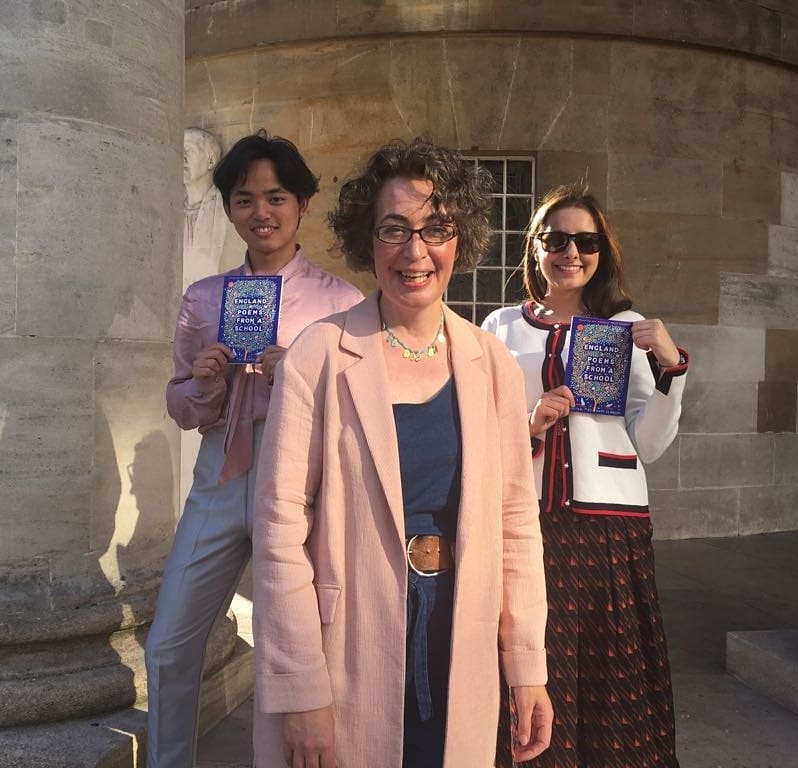
Kate Clanchy and her students. Source: @england_the_poems (Instagram)
Her anthology, England: Poems from a School,25 showcases poems by immigrant schoolchildren from Oxford Spires Academy. It is one of the Academy’s many projects designed to promote the practice of poetry in education.26 These students hail from various parts of the world—Korea, Syria, Afghanistan, Brazil, Lithuania and Poland—and in this anthology they share their stories of displacement, living through war zones, and missing a home to which they cannot return.
Azfa Awad, 18, recalls being five years old and “trapped / between the claws of war”. But she paints a scene of strength: “my voice could soar … And when I ran / away from [the soldiers’] biting guns, / my feet could dance, skim above rose petals / dripping from my toes.” Amineh Abou Kerech, 13, asks: “Can anyone teach me / how to make a homeland?” Mohamed Assaf, 12, criticises the generalisations that statistics and mass media make about Syrian people which strip them of their identities: “Nations talked to nations / and robbed me of myself. / They made me / a number among millions. / But my rights have no numbers.”
Visual and Performance Art
Visual and performance art provide accessible and entertaining—even occasionally confronting—depictions of everyday lived realities. Many of these works offer some sort of social and political commentary.
Plays
In Australia, plays like the Sydney Theatre Company’s Going Down 27 (a semi-autobiographical story of a young Asian woman’s confused journey with sex and literature) and the Hellenic Art Theatre’s Brushstrokes 28(whish discusses stigma faced by people with disabilities in migrant communities) are disrupting narratives. Such plays also have important social functions—Going Down smashed the stereotype of the polite, compliant Asian woman to highlight the diversity and complexity within migrant and multicultural communities, while Brushstrokes worked to educate Greek migrants about the benefits of accessing the National Disability Insurance Service.
De’VIA
Within the Deaf community in North America, a genre of visual art called Deaf View/Image Art (De’VIA) represents and raises awareness of deaf experiences and culture. De’VIA generally falls in two themes: resistance and affirmation. The former explores “audism, oralism, identity confusion, and eugenics” while the latter demonstrates empowerment through “sign language, group affiliation, acculturation, and Deafhood”.29 Engaging with De’VIA can be therapeutic for deaf artists, encourage Deaf visibility and cultural development, while also bridging conversations between the Deaf and hearing communities.
Refugee Art
The visual arts is another medium through which refugees and asylum-seekers can find their voice and agency. The Refugee Art Project30 aims to present alternative points of view, ideas and narratives that combat common public perceptions of refugees as “criminals” and “terrorists”. Established in 2010 in Sydney, Australia, it began with a small group of artists and academics going into Villawood detention centre to hold art classes.31 To date, there have been several public exhibitions showcasing works produced in those classes. Such creative expressions of lived experience are crucial in a context where asylum-seekers continue to be detained over the long term.
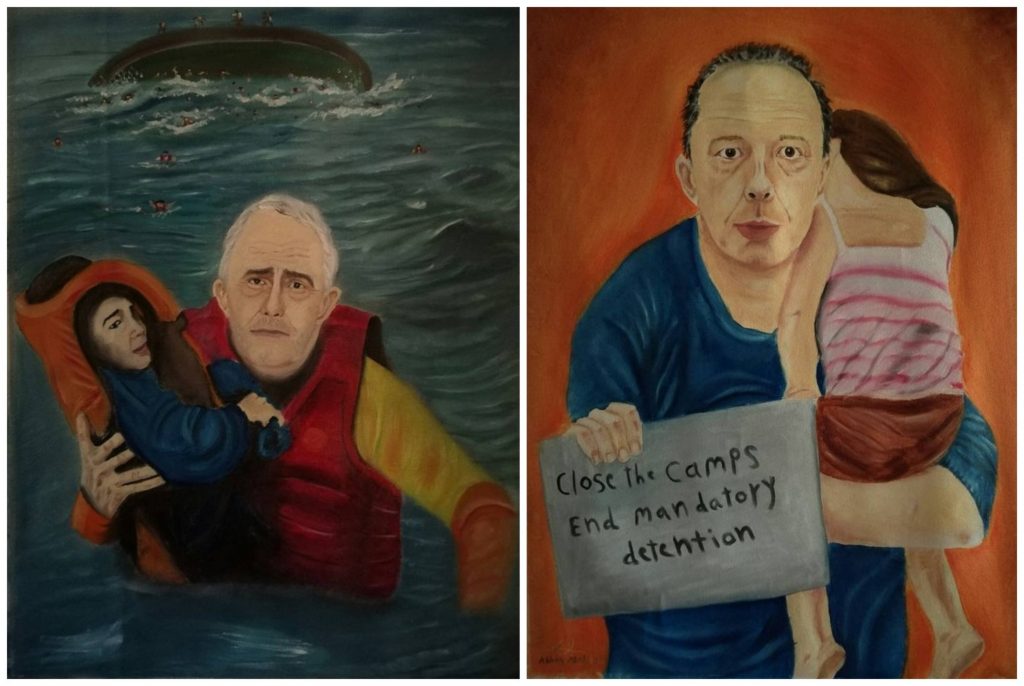
If Malcolm Turnbull and Peter Dutton were refugees. Source: Abbas al Abourdi.
Some refugee artists supported by the Project include Abbas al Alaboudi, who has been detained at Nauru detention centre for over five years since he fled his hometown of Baghdad in 2013 amid an upsurge in violence in Iraq. To overcome feelings of helplessness over the direction of his future, Abbas turned to his childhood passion: art. His paintings have since been commissioned for between AU$150–$300 on Facebook and e-commerce website, Etsy. In two of his paintings, Abbas re-envisions former Australian Prime Minister Malcolm Turnbull and former Minister for Home Affairs Peter Dutton as refugees. They are the politicians whom he sees as being responsible for the policies that trap him and others inside detention centres. Turnbull is shown holding a child in a lifejacket while Dutton clasps to a poster with the words: “Close the camps. End mandatory detention.”
Personal Healing and Awareness Education
Abuse and Recovery
When Peter Blenkiron was 11 years old, he was abused by a St Patrick’s College Christian Brother. The experience left him a damaged man , spurring him to spend more than a decade in a process of healing. Blenkiron documented this journey with his smartphone, assembling the pieces together to create a photographic diary entitled “Putting the Pieces of the Self Together One Moment at a Time”.32 The photo exhibition, curated by Vanessa Beetham, is a snapshot into the “inner world” of a child abuse survivor as he “learns to re-inhabit his body and mind” in his search of light in the darkness. “I sit with an image until it grabs me. I take a photo and it connects my inner world and outer world. They merge. The photo acts as a bridge,” says Blenkiron. Exhibitions like this can have a huge social impact. In Beetham’s words, “[t]he story of one is the story of countless others.”

Peter Blenkiron’s exhibition at The Art Gallery of Ballarat (left) and The Dax Centre (middle and right), courtesy of Vanessa Beetham.
Blenkiron’s exhibition is one of the many showcased at The Dax Centre ,33 a Melbourne-based not-for-profit organisation promoting mental health and well-being by using art to improve people’s understanding of and empathy for the mind.
Trauma and Therapy
The Dax Centre is also home to the Cunningham Dax Collection,34 a series of some 15,000 artworks 35 accrued since 1946, created by individuals with experience of mental illness and psychological trauma. This collection includes 250 artworks created by adults who suffered physical, mental and sexual abuse during their childhood as well as therapeutic artworks made in the aftermath of the 2009 Victorian bushfires and the 2004 Indian Ocean tsunami. Art-making at the grassroots level became a way for these individuals to express thoughts, emotions and experiences that escaped the realm of words because they were often too painful to articulate.
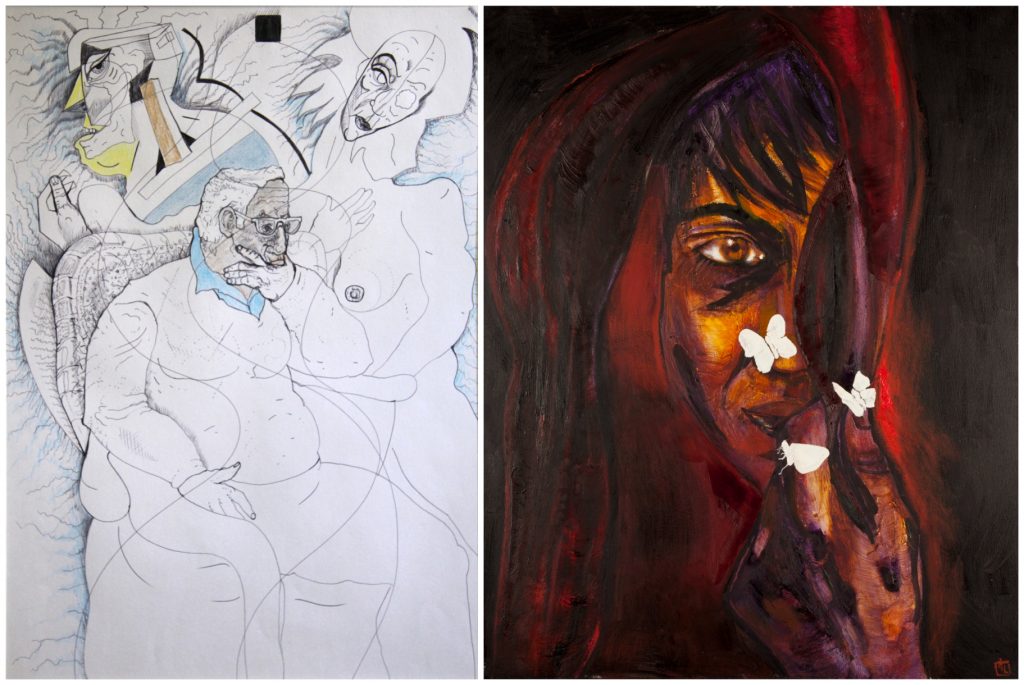 Artworks in the Cunningham Dax Collection. (Left) Graeme Doyle, Untitled, undated, ballpoint pen and coloured pencil on paper, 36.9 x 27cm; (right) Donna Lawrence, Untitled, c.1990, acrylic on canvas, 100 x 80cm. © The artists, images courtesy of The Dax Centre.
Artworks in the Cunningham Dax Collection. (Left) Graeme Doyle, Untitled, undated, ballpoint pen and coloured pencil on paper, 36.9 x 27cm; (right) Donna Lawrence, Untitled, c.1990, acrylic on canvas, 100 x 80cm. © The artists, images courtesy of The Dax Centre.
Awareness Education
Each year, around 3,000 secondary and 1,000 tertiary students also partake in the Dax Centre education programme, designed to encourage mental health literacy and to highlight the creative capabilities of those living with mental illness. Talks are given by two speakers—an individual with lived experience of mental illness and a neuroscientist—and include an introductory tour of artworks representing a diversity of mental illness experiences.36 There is a great need for exhibitions and educational programs like the ones offered at The Dax Centre to be used as the first steps to overcoming the stigma around mental illness. Although mental health was voted as the most important national issue by young people in a 2017 Mission Australia survey,37 a rhetoric of shame and silence around mental illness persists. This rhetoric is even more intense among immigrant communities where cultural reasons 38 contribute to deep-seated stigmatisation. Some Asian cultures, for instance, associate mental illness with violent behaviour or see it as a sign of weakness contrary to the stoic demeanour expected of men. These attitudes have consequences: in Australia, six men take their own lives every day and suicide is the leading cause of death 39 for men under 45 years of age. But what The Dax Centre proves is this: these attitudes can be changed through the connecting power of art.
Fundamentally, art offers an avenue for individuals and communities to interrogate and carve out their places in the world. It holds up a mirror both to the self and society, and can explore and challenge commonly held beliefs.
“If a work of art is rich, and vital, and complete, those who have artistic instincts will see its beauty, and those to whom ethics appeal more strongly than aesthetics will see its moral lesson. It will fill the cowardly with terror, and the unclean will see in it their own shame.”—Oscar Wilde, in response to critical appraisal of his novel, The Picture of Dorian Gray.40
Banner: Photo by Una Laurencic via Pexels
Notes
- Guy Abrahams, Kelly Gellatly and Bronwyn Johnson, eds., Art + Climate = Change (Melbourne: Melbourne University Press, 2016); Frank Burch Brown, “Introduction: Mapping the Terrain of Religion and the Arts”, in The Oxford Handbook of Religion and the Arts, ed. Frank Burch Brown (New York: Oxford University Press, 2014), 1–21.
- Jean-Paul Sartre, What Is Literature? trans. Bernard Frechtman (Oxford and New York: Routledge, 1948); Pamela Rydzewski, Art and Human Experience (Oxford and London: Pergamon Press, 1967).
- Abrahams, Gellatly and Johnson, eds., Art + Climate = Change.
- Melanie Boyce and Carol Munn-Giddings, “The Impact of the Arts in Healthcare on Patients and Service Users: A Critical Review”, Health & Social Care in the Community 26, 4 (2018): 458–73; Stine L. Nielsen, Lars B. Fich, Kirsten K. Roessler and Michael F. Mullins, “How Do Patients Actually Experience and Use Art in Hospitals? The Significance of Interaction: A User-Oriented Experimental Case Study”, International Journal of Qualitative Studies on Health and Well-Being 12, 1 (2017): 1267343.
- Albert Camus, The Rebel: An Essay on Man in Revolt (New York: Vintage, 1991).
- Adrienne Rich, What Is Found There: Notebooks on Poetry and Politics (New York and London: W.W. Norton & Company, 1994).
- Audre Lorde, Sister Outsider: Essays and Speeches (Berkeley: Crossing Press, 1984); Cherríe Moraga, The Last Generation: Prose and Poetry (Boston: South End Press, 1986).
- Anne Schwan, "Introduction: Reading and Writing in Prison", Critical Survey 23, 3 (2011): 1–5.
- Behrouz Boochani, No Friend but the Mountains: Writing from Manus Prison (Sydney: Pan Macmillan Australia, 2018).
- Michael D. Jackson, At Home in the World (Durham and London: Duke University Press, 1995).
- Dale M. Smith, Beyond the Barricade: Rhetoric, Citizenship and Dissent after 1960 (Tuscaloosa: University of Alabama Press, 2012).
- Colin Wells, Poetry Wars: Verse and Politics in the American Revolution and Early Republic (Philadelphia: University of Pennsylvania Press, 2018).
- Claudia Rankine, Citizen: An American Lyric (Minneapolis: Graywolf Press, 2014).
- James Baldwin and Studs Terkel, "An Interview with James Baldwin", in Conversations with James Baldwin, ed. Fred L. Standley and Louis H. Pratt (Jackson and London: University Press of Mississippi, 1989), pp. 3–23.
- [1] Rachel Sutton-Spence and Ronice Müller de Quadros, ‘“I Am The Book”—Deaf Poets’ Views on Signed Poetry", Journal of Deaf Studies and Deaf Education 19, 4 (2014): 546–58.
- Maddie Crum, “Meet the Man Bringing Slam Poetry to the Deaf Community”, Huffington Post, 25 May, 2017, https://www.huffingtonpost.com.au/entry/meet-the-man-bringing-slam-poetry-to-the-deaf-community_us_591f43f6e4b03b485cb17c33
- Daniel Gordon, “UK’s First Sign Language Poetry Slam”, BBC, 21 July 2017, https://www.bbc.com/news/av/disability-40670284/uk-s-first-sign-language-poetry-slam
- “Deaf Slam Poetry Workshops”, Arts Access Victoria, https://www.artsaccess.com.au/deaf-slam-poetry-workshops-2
- Judy Lieff, “Deaf Jam”, PBS, 3 November, 2011, http://www.pbs.org/independentlens/films/deaf-jam
- Crum, “Meet the Man Bringing Slam Poetry to the Deaf Community”.
- Rachel Sutton-Spence and Ronice Müller de Quadros, “‘I Am the Book’—Deaf Poets’ Views on Signed Poetry”, Journal of Deaf Studies and Deaf Education 19, 4 (2014): 546.
- Susan B.A. Somers-Willett, “Slam Poetry and the Cultural Politics of Performing Identity”, The Journal of the Midwest Modern Language Association 38, 1 (2005): 52.
- Gordon, “UK’s First Sign Language Poetry Slam”.
- Deaf Jam, directed by Judy Lieff (New York: New Day Films, 2011), Kanopy.
- Kate Clanchy, England: Poems from a School (London: Picador, 2018).
- Oxford Spires Academy, “Poetry Hub”, http://www.oxfordspiresacademy.org/student/poetry-hub
- Sydney Theatre Company Limited, “Going Down”, https://www.sydneytheatre.com.au/whats-on/productions/2018/going-down
- Themi Kallos and Stergos Kastelloriou, “Hellenic Art Theatre Connects Migrant Communities with Government NDIS Services”, SBS, 13 April 2018, https://www.sbs.com.au/yourlanguage/greek/en/audiotrack/hellenic-art-theatre-connects-migrant-communities-government-ndis-services
- Paula Bath, "Deconstructing Phonocentrism: A New Genre in Deaf Arts", in Mobilizing Metaphor: Art, Culture, and Disability Activism in Canada, ed. Christine Kelly and Michael Orsini (Vancouver and Toronto: UBC Press, 2016), 181–97.
- Safdar Ahmed, “Refugee Art Project”, https://safdarahmed.com/refugee-art-project
- Tedx Talks, “Art, Ingenuity + Refugees: Syed Safdar Ahmed at TEDxParramatta”, YouTube video, published 30 August 2012, https://www.youtube.com/watch?v=M7Wi8vqhze0&feature=youtu.be
- “Peter Blenkiron—Putting the Pieces of the Self Back Together One Moment at a Time”, Photo Exhibition at the Dax Centre, 30 June to 21 July 2018, https://www.daxcentre.org/event/putting-the-pieces-of-the-self-back-together-one-moment-at-a-time
- The Dax Centre, “About Us”, https://www.daxcentre.org/the-dax-centre-about-us
- The Dax Collection, “The Cunningham Dax Collections”, https://www.daxcentre.org/collection
- The Dax Centre and Asia Australia Mental Health, Creative Opportunities: Report on the Asia Pacific Art and Mental Health Symposium 9 November 2011, http://aamh.edu.au/wp-content/uploads/2014/01/Creative_Opportunites_Report.pdf
- Eugen Koh, “The Cunningham Dax Collection: A Unique Mental Health Resource”, Australasian Psychiatry 22, 1 (2014): 41–3, http://journals.sagepub.com/doi/abs/10.1177/1039856213517951?journalCode=apya
- Christopher Knaus, “’Sadness Is All You Have’: Why Youth Mental Health Is in Need of Urgent Help”, The Guardian, 6 December 2017, https://www.theguardian.com/australia-news/2017/dec/07/sadness-is-all-you-have-why-youth-mental-health-is-in-need-of-urgent-help
- David Mellor, Lucy Carne, Yu-Chun Shen, Marita McCabe and Liwei Wang, “Stigma Toward Mental Illness: A Cross-Cultural Comparison of Taiwanese, Chinese Immigrants to Australia and Anglo-Australians”, Journal of Cross-Cultural Psychology 44, 3 (2012): 352–64.
- Julia Gillard, “Julia Gillard: The Stigma around Mental Health Nearly Cost Australia Its Greatest Leader”, The Guardian, 28 June 2017, https://www.theguardian.com/commentisfree/2017/jun/29/julia-gillard-the-stigma-around-mental-health-nearly-cost-australia-its-greatest-leader
- Oscar Wilde, The Complete Letters of Oscar Wilde, ed. Merlin Holland and Rupert Hart-Davis (New York: Henry Holt and Company, 2000).
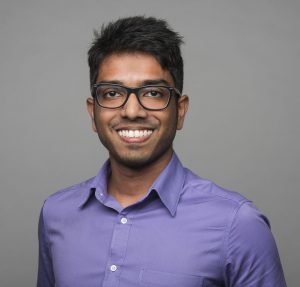 |
Sujith Kumar Prankumar is a PhD student researching sexual citizenship and belonging at the Centre for Social Research in Health, UNSW Sydney. He was a former web editor with Social Space Magazine, and his work has been published in various print and online publications. Sujith studied gender and religion with Harvard University, human rights with Columbia University and communications with the University of South Australia. He can be reached at contact@sujithkumar.net |
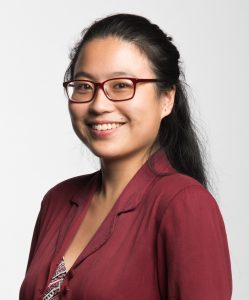 |
Katherine O’Chee is a Media and Communications undergraduate from the University of Sydney. Her topics of interest include immigration, mental health, cultural identity, women’s rights and the environment. Katherine’s writing has been published in the Bangkok Post, SBS News, Sydney Morning Herald and Honi Soit, among others. She is a poet in her spare time, and enjoys learning Asian languages including Mandarin and Korean. Katherine can be reached at katherine.ochee@hotmail.com or via Twitter @bookrangerkath |
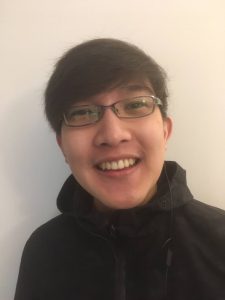 |
Supharirk James Chiraphatnachai is an undergraduate at the University of Sydney, majoring in English and Film Studies. He is passionate about literature and co-founded the university’s Book Society. In addition to being a student, James works as a duty manager at a bookstore. Apart from books, he enjoys films, music and writing. James was born profoundly deaf and wears bilateral cochlear implants. He can be reached at james.chiraphatnachai@gmail.com |

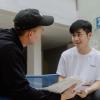

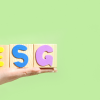
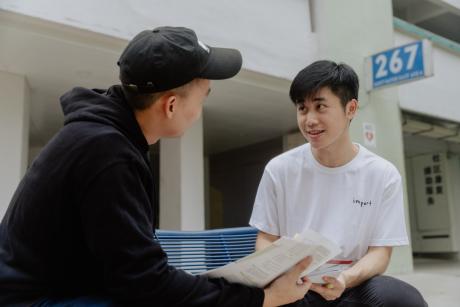

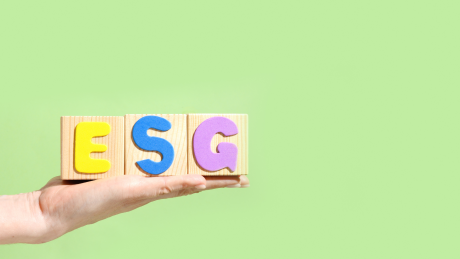
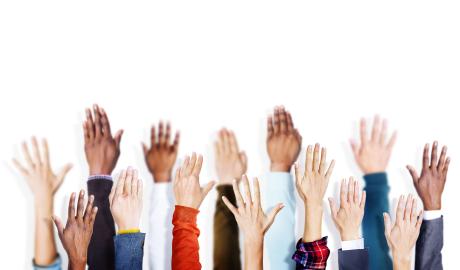
Comments